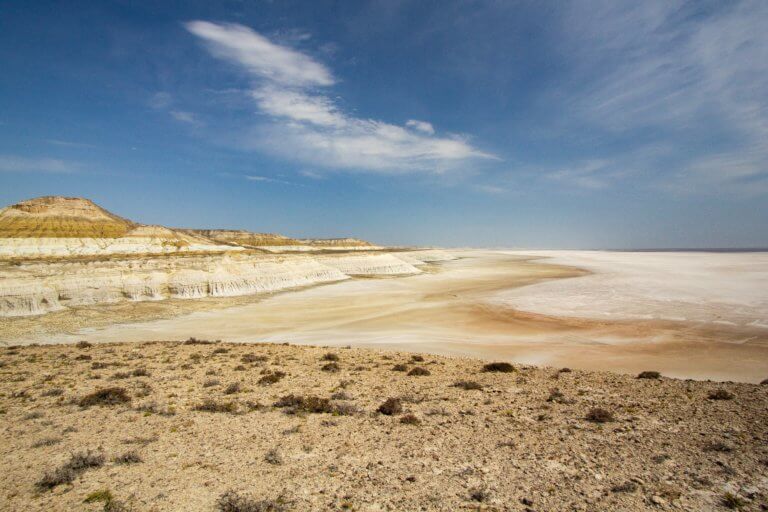
Boszhira
Boszhira is Central Asia’s rival to the USA’s Monument Valley National Park, with the bonus of no crowds. Packed into a 7km x 7km area
The Akkegershin Plateau is an area of chalk upland 55km north-east of Kulsary town. It measures approximately 8km x 12km and is 50km west of the larger Aktolagay Plateau.
The plateau boasts an array of wind-carved chalk formations, with the most stunning examples at a northern viewpoint. Among these natural sculptures are the ‘Three Heroes’, ‘Camel’, ‘Aurora’, and ‘Elephant’, each with its own distinctive shape and story. Look closely and you’ll see signs of the ancient Paratethys Sea. It once covered the area during the Jurassic and Cretaceous Era, leaving behind fossilised shells, ammonites, belemnites, shark teeth, and other extinct marine animals embedded in the chalk.
Heads-up: Avoid climbing on any rock features in the Aktolagay and Akkegershin Plateaus, as the chalk is fragile, especially after any rainfall.
From Atyrau, it’s a 220 km+, three- to four-hour drive to Kulsary on the A-27 and R-110 roads. The drive from Aktau, on the A-33, is 670 km+ and takes over eight hours.
The KE-10 is the final stretch of road leading to the plateau and the turn-off is less than 15 km north of Kulsary. Although it’s an official thru-road to Mukur town, it’s not an easy drive as there are long stretches of mud and heavily worn asphalt. Kulsary is the last point to stock up on food, petrol and water.
Magnet Camping, at the southern end of Kulsary, has several rooms. Half a kilometre to the east is Shankay Hotel. There’s also Kulsary Hotel at the northern end. On the plateau, you can park and camp anywhere.
Akkegershin Plateau viewpoint (Aqkegerşın Üstırtı/Плато Аккегершин): 47.3200, 54.4090
Mukur Village (Mūqyr/Город Мукыр): 48.0460, 54.4912
Kulsary Town (Qūlsary/Город Кульсары): 46.9616, 54.0126
KE-10 road: 47.0879, 54.0456
1:500k Soviet map of the Aktolagay Plateau, shown in the top left of the centre, marked as “Гряда Актолагай”. Akkegershin is in the top-left quarter, in the raised area just south of Mount Imankara, marked as “г. Иманкара (200m)”.
1:200k Soviet map of the Emba River, with the Akkegershin Plateau shown near the centre of the top edge, marked as “г. Аккерeгешын (95m)”. Kulsary is near the centre of the left edge.
Alexey Ignatkovich’s richly illustrated report for a multi-week road trip in western Kazakhstan, including photos of the Akkegershin Plateau and the challenging KE-10 road.
Lyudmila Sultanova’s Akkegershin Plateau trip report, which includes photographs of fossilised sea urchin shells and quills, as well as petrified sea lily trunks.
A short documentary about visiting the Akkegershin Plateau with quad bikes, as well as the Aktolagay Plateau.
Drone videos of Akkegershin’s rock features and a popular viewpoint and camping spot in the north.
Russian overlander Edward Prima’s Akkegershin video.

Boszhira is Central Asia’s rival to the USA’s Monument Valley National Park, with the bonus of no crowds. Packed into a 7km x 7km area

Eight kilometres south of Kyzyl Ravine is Sor Tuzbair*, a salt marsh stretching 15km along the edge of the Western Chink Ustyurt. Along with Boszhira,

Fifteen kilometres north-west of Shetpe town is Ayrakty-Shomanai, or as 19th-century Ukrainian artist-poet Taras Shevchenko preferred to call it during his stay in Mangystau, ‘The
Copyright © Planet Esoterica, 2024. No part of this site, www.planetesoterica.com, may be reproduced in whole or in part in any manner without the permission of the copyright owner. All rights reserved.
Made with 